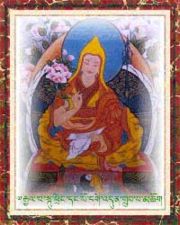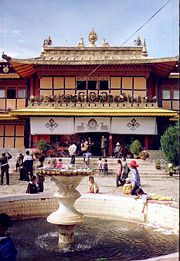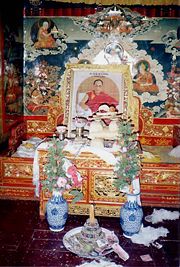Dalai Lama
2008/9 Schools Wikipedia Selection. Related subjects: Religious figures and leaders
| This article contains Indic text. Without rendering support, you may see question marks, boxes or other symbols instead of Indic characters; or irregular vowel positioning and a lack of conjuncts. |
| Dalai Lama | |
|---|---|
| Tibetan name | |
| Tibetan: | ཏཱ་ལའི་བླ་མ་ |
| Wylie transliteration: | taa la’i bla ma |
| pronunciation in IPA: | [taːlɛː lama] |
| official transcription (PRC): | Dalai Lama |
| THDL: | Dalai Lama |
| other transcriptions: | — |
| Chinese name | |
| traditional: | 達賴喇嘛 |
| simplified: | 达赖喇嘛 |
| Pinyin: | Dálài Lǎmā |
Tibetan Buddhists believe that the Dalai Lamas form an unbroken lineage of reborn incarnations of Chenresig (spyan ras gzigs; Sanskrit: Avalokiteśvara), the bodhisattva of compassion, which stretches back to the birth of Gendun Drup, the 1st Dalai Lama, in 1391 AD.
Between the 17th century and 1959, the Dalai Lama was the head of the Tibetan government, administering a large portion of the country from the capital Lhasa. He is often referred to simply as " His Holiness" (HH), or "His Holiness The Dalai Lama". The Dalai Lama is often thought to be the head of the Gelug School, but this position officially belongs to the Ganden Tripa ( Wylie: Dga'-ldan Khri-pa). Tibetans usually call the Dalai Lama Gyalwa Rinpoche ( Tibetan: རྒྱལ་བ་རིན་པོ་ཆེ; Wylie: Rgyal-ba Rin-po-che) meaning "Precious Victor," or Yeshe Norbu ( Tibetan: ་ཡིད་བཞིན་ནོར་བུ; Wylie: Yid-bzhin Nor-bu) meaning "Wish-fulfilling Jewel".
History
"Dalai" means "Ocean" in Mongolian, and is a translation of the Tibetan name "Gyatso", while " Lama" (bla ma) is the Tibetan equivalent of the Sanskrit word " guru", and is commonly translated to mean "spiritual teacher".
It has been commonly claimed that the title "Dalai Lama" was first bestowed by the Mongolian ruler Altan Khan upon Sonam Gyatso in 1578. This, however, is not true. Sonam Gyatso, "was invited to Mongolia by the famous conqueror Altan Khan, and on his arrival at the latter's camp the Khan addressed him in Mongol by the name of Dalai lama, the Tibetan word gyatso, "ocean," being the equivalent of dalai in Mongol. Altan, knowing that the lama's predecessor had also the word gyatso in his name, took it for a family name; and this mistake has been the origin of the name of Dalai Lama since given to all the reincarnations of the Grand Lama." This interpretation of the name Dalai Lama has been confirmed by Tenzin Gyatso, the Fourteenth Dalai Lama: "So I don't really agree that the Mongols actually conferred a title. It was just a translation."
Sonam Gyatso was an Abbot at the Drepung Monastery who was widely considered the most eminent lama of his time. Although Sonam Gyatso became the first lama to hold the title "Dalai Lama", due to the fact that he was the third member of his lineage, he became known as the "Third Dalai Lama". The previous two titles were conferred posthumously upon his earlier incarnations.
Tibetans address the Dalai Lama as Gyalwa Rinpoche ('Precious Victor'), Kundun ('Presence') Yishin Norbu (' Wishfulfilling Gem'), and so on.
The Fifth Dalai Lama, with the support of Gushri Khan (1582-1655), a Mongol ruler of Kokonor, united Tibet.
- "After him [Jamphel Gyatso the VIIIth Dalai Lama (1758-1804)], the IXth and Xth Dalai Lamas died before attaining their majority: one of them is credibly stated to have been murdered and strong suspicion attaches to the other. The XIth and XIIth were each enthroned but died soon after being invested with power. For 113 years, therefore, supreme authority in Tibet was in the hands of a Lama Regent, except for about two years when a lay noble held office and for short periods of nominal rule by the XIth and XIIth Dalai Lamas.
- It has sometimes been suggested that this state of affairs was brought about by the Ambans—the Imperial Residents in Tibet—because it would be easier to control Tibet through a Regent than when a Dalai Lama, with his absolute power, was at the head of the government. That is not true. The regular ebb and flow of events followed its set course. The Imperial Residents in Tibet, afer the first flush of zeal in 1750, grew less and less interested and efficient. Tibet was, to them, exile from the urbanity and culture of Peking; and so far from dominating the Regents, the Ambans allowed themselves to be dominated. It was the ambition and greed for power of Tibetans that led to five successive Dalai Lamas being subjected to continuous tutelage."
Thubten Jigme Norbu, the elder brother of the present 14th Dalai Lama, describes these unfortunate events as follows:
- "It is perhaps more than a coincidence that between the seventh and the thirteenth holders of that office, only one reached his majority. The eighth, Gyampal Gyatso, died when he was in his thirties, Lungtog Gyatso when he was eleven, Tsultrim Gyatso at eighteen, Khadrup Gyatso when he was eighteen also, and Krinla Gyatso at about the same age. The circumstances are such that it is very likely some, if not all, were poisoned, either by loyal Tibetans for being Chinese-appointed impostors, or by the Chinese for not being properly manageable."
Thubten Gyatso, the 13th Dalai Lama, assumed ruling power from the monasteries which previously had great influence in the Regent, in 1895. Due to his two periods of exile in 1904-9, to escape the British invasion of 1904, and from 1910-1912 to escape a Chinese invasion, he became well aware of the complexities of international politics and was the first Dalai Lama to become aware of the importance of foreign relations. After his return from exile in India and Sikkim in January, 1913 he took control of foreign relations and dealt directly with the Maharaja and the British Political officer in Sikkim and the king of Nepal rather than letting the Kashag or parliament handle it.
Thubten Gyatso issued a Declaration of Independence from China in the summer of 1912, and standardized the Tibetan flag in its present form. He deported all Chinese residents in the country including the Ambans, and instituted many measures to modernise Tibet.
The Dalai Lamas continued to rule Tibet until the People's Republic of China invaded the region in 1949 and then took full control in 1959. The 14th Dalai Lama then fled to India and has since ceded temporal power to an elected government-in-exile. The current 14th Dalai Lama seeks greater autonomy for Tibet.
Succession of reborn Dalai Lamas
The title "Dalai Lama" is presently granted to each of the spiritual leader's successive incarnations (for example, The 14th Dalai Lama's next incarnation will hold the title "the 15th Dalai Lama").
Upon the death of the Dalai Lama, his monks institute a search for the Lama's reincarnation, or yangsi (yang srid), a small child. Familiarity with the possessions of the previous Dalai Lama is considered the main sign of the reincarnation. The search for the reincarnation typically requires a few years. The reincarnation is then brought to Lhasa to be trained by the other Lamas.
List of Dalai Lamas
There have been 14 Dalai Lamas:
| Name | Picture | Lifespan | Reign | Tibetan/ Wylie | PRC transcription | Other English spelling(s) | |
|---|---|---|---|---|---|---|---|
| 1. | Gendun Drup |  |
1391–1474 | No | དྒེ་འདུན་འགྲུབ་ dge ‘dun ‘grub |
Gêdün Chub | Gedun Drub, Gedün Drup, Gendun Drup |
| 2. | Gendun Gyatso | Image:2ndDalaiLama.jpg | 1475–1541 | No | དགེ་འདུན་རྒྱ་མཚོ་ dge ‘dun rgya mtsho |
Gêdün Gyaco | Gedün Gyatso, Gendün Gyatso |
| 3. | Sonam Gyatso |  |
1543–1588 | 1578–1588 | བསོད་ནམས་རྒྱ་མཚོ་ bsod nams rgya mtsho |
Soinam Gyaco | Sönam Gyatso |
| 4. | Yonten Gyatso |  |
1589–1616 | ? | ཡོན་ཏན་རྒྱ་མཚོ་ yon tan rgya mtsho |
Yoindain Gyaco | Yontan Gyatso |
| 5. | Lobsang Gyatso |  |
1617–1682 | 1642–1682 | བློ་བཟང་རྒྱ་མཚོ་ blo bzang rgya mtsho |
Lobsang Gyaco | Lobzang Gyatso, Lopsang Gyatso |
| 6. | Tsangyang Gyatso |  |
1683–1706 | ?–1706 | ཚང་དབྱངས་རྒྱ་མཚོ་ tshang dbyangs rgya mtsho |
Cangyang Gyaco | |
| 7. | Kelzang Gyatso |  |
1708–1757 | 1751–1757 | བསྐལ་བཟང་རྒྱ་མཚོ་ bskal bzang rgya mtsho |
Gaisang Gyaco | Kelsang Gyatso, Kalsang Gyatso |
| 8. | Jamphel Gyatso |  |
1758–1804 | 1786–1804 | བྱམས་སྤེལ་རྒྱ་མཚོ་ byams spel rgya mtsho |
Qambê Gyaco | Jampel Gyatso, Jampal Gyatso |
| 9. | Lungtok Gyatso |  |
1806–1815 | (1808–1815) | ལུང་རྟོགས་རྒྱ་མཚོ་ lung rtogs rgya mtsho |
Lungdog Gyaco | Lungtog Gyatso |
| 10. | Tsultrim Gyatso |  |
1816–1837 | ? | ཚུལ་ཁྲིམ་རྒྱ་མཚོ་ tshul khrim rgya mtsho |
Cüchim Gyaco | Tshültrim Gyatso |
| 11. | Khendrup Gyatso |  |
1838–1856 | 1844–1856 | མཁས་གྲུབ་རྒྱ་མཚོ་ mkhas grub rgya mtsho |
Kaichub Gyaco | Kedrub Gyatso |
| 12. | Trinley Gyatso |  |
1857–1875 | ? | འཕྲིན་ལས་རྒྱ་མཚོ་ ‘phrin las rgya mtsho |
Chinlai Gyaco | Trinle Gyatso |
| 13. | Thubten Gyatso |  |
1876–1933 | ? | ཐུབ་བསྟན་རྒྱ་མཚོ་ thub bstan rgya mtsho |
Tubdain Gyaco | Thubtan Gyatso, Thupten Gyatso |
| 14. | Tenzin Gyatso |  |
1935–present | 1950–present (currently in exile) |
བསྟན་འཛིན་རྒྱ་མཚོ་ bstan ‘dzin rgya mtsho |
Dainzin Gyaco |
Residence
Starting with the 5th Dalai Lama and until the 14th Dalai Lama's flight into exile in 1959, the Dalai Lamas resided during winter at the Potala Palace, and in the summer at the Norbulingka palace and park. Both residences are located in Lhasa, Tibet, approximately 3 km apart.
In 1959, subsequent to the then ongoing Chinese occupation of Tibet, the 14th Dalai Lama sought refuge within India. The then Indian Prime Minister, Jawaharlal Nehru was instrumental in granting safe refuge to the Dalai Lama and his fellow Tibetans. The Dalai Lama has since been in refuge in Dharamsala, in the state of Himachal Pradesh in northern India, where the Central Tibetan Administration (the Tibetan government-in-exile) is also established. Tibetan refugees have constructed and opened many schools and Buddhist temples in Dharamsala.
The future of the Dalai Lama
Despite its officially secular stance, the government of the People's Republic of China (PRC) has claimed the power to approve the naming of high reincarnations in Tibet. This decision cites a precedent set by the Qianlong Emperor of the Qing Dynasty, who instituted a system of selecting the Dalai Lama and the Panchen Lama by means of a lottery which utilised a golden urn with names wrapped in barley balls. Controversially, this precedent was called upon by the PRC to name their own Panchen Lama. The Dalai Lama and the Tibetan Buddhists in exile do not regard this to be the legitimate Panchen Lama. The Dalai Lama has recognized a different child, Gedhun Choekyi Nyima, as the reincarnated Panchen Lama. This child and his family have been taken into 'protective custody' according to the PRC, and all attempts by members of the EU parliament and US government to garner guarantees of the family's safety have been denied by the PRC. In September 2007 the Chinese government said all high monks must be approved by the government, which would include the selection of the 15th Dalai Lama after the death of Tenzin Gyatso. The People's Republic of China may attempt to direct the selection of a successor using the authority of their chosen Panchen Lama.
In response to this scenario, Tashi Wangdi, the representative of the 14th Dalai Lama, replied that the Chinese government's selection would be meaningless. "You can’t impose an Imam, an Archbishop, saints, any religion…you can’t politically impose these things on people," said Wangdi. "It has to be a decision of the followers of that tradition. The Chinese can use their political power: force. Again, it’s meaningless. Like their Panchen Lama. And they can’t keep their Panchen Lama in Tibet. They tried to bring him to his monastery many times but people would not see him. How can you have a religious leader like that?"
The purpose of a reincarnation is to complete work begun by the previous incarnation, the Dalai Lama is reported to have said. Thus logically as the current Dalai Lama escaped from Chinese control, the next -- if any -- would be born outside of Chinese control. The Dalai Lama said as early as 1969 that it was for the Tibetans to decide whether the institution of the Dalai Lama "should continue or not." He has given reference to a possible vote occurring in the future for all Tibetans Buddhists to decide whether they want him to be "reborn".



